A look ahead at the dialysis provider-payer mix and partnerships
The passage of the 21st Century Cures Act of 2016 includes a measure that expands eligibility for Medicare Advantage plans to patients with ESRD by 2021. As these beneficiaries become a larger share of Medicare Advantage plans’ total enrollment, there will be unintended revenue and cost inconsistencies for plans and providers. Based on the calculations presented here, Medicare Advantage ESRD enrollment could gradually increase from 14% to more than 41% of all payers during the next 4 years.
In this article, I address the impact of this legislation and other major factors influencing future dialysis payer mix changes. I also propose actions dialysis providers and nephrologists can take to mitigate the risks from these changes. Having a plan of action could lead to a smoother transition into this evolving health care environment.
Look at the numbers
On Dec. 31, 2015, there were 703,243 prevalent cases of ESRD, of which 29.6% had a functioning transplant. Subtracting functioning transplant patients brings the total dialysis-only population to 495,000.1 Assuming Medicare represents 80% of the 495,000 (396,000) of which 14% of that group (71,280) are enrolled in Medicare Advantage health plans includes those in non-special needs plan (SNP) Medicare Advantage plans,2 this leaves 324,720 enrolled in original Medicare. We can estimate that of the remaining 20%, 10% of patients are covered by Medicaid and 10% of patients by employer-based coverage. See Table 1 for breakdown.

Aside from the 21st Century Cures Act, three other legislative and administration actions will radically impact this payer mix in the next 4 years in both Medicare and Medicaid ESRD coverage. They include accountable care organizations, Section 1115 Medicaid waivers and the Dialysis Patient Demonstration Act (DPDA), or something similar, if passed by Congress. We will go through each action in detail.
Medicare Advantage plans
On Dec. 13, 2016, President Obama signed the 21st Century Cures Act (Public Law No: 114-255, also known as “Cures,” H.R. 34.3 Current law prohibits people with ESRD from enrolling in Medicare Advantage plans except in limited situations. Beginning in calendar year 2021, Section 17006 of the Cures Act will remove the barrier for people with ESRD to enroll in Medicare Advantage plans.
For beneficiaries with ESRD enrolled in original fee-for-service (FFS) Medicare, the decision to enroll in a Medicare Advantage health plan will depend on their age, income level, current coverage and plan benefits, copays, deductibles, premiums and residence in one of the 31 states that grant Medigap protection.4 State Medigap protection is important because it guarantees the Medicare supplement plan cannot deny enrollment to a beneficiary with ESRD.
The 324,729 beneficiaries currently covered by original Medicare FFS will be most affected by changes in future payer mix because of the new Medicare Advantage option. This requires a significant educational effort so patients understand the options, including the availability of the Part D drug benefit in some cases.
The following are assumptions based on my experience developing and managing Medicare Advantage ESRD SNPs in several states.
Dual-eligible beneficiaries
Approximately 50% of the 324,729 beneficiaries (n=162,365) are dual eligible for Medicare and Medicaid coverage for their ESRD. After 2021, dual-eligible beneficiaries may consider enrolling in Medicare Advantage plans, but they must be either a dual-eligible Medicare Advantage plans (D-SNP) or Medicare Advantage ESRD Chronic Care Special Needs plans (C-SNP) that coordinate secondary payments with Medicaid. Enrollment in Medicare Advantage plans will vary by county and availability of D-SNPs and/or ESRD C-SNPs.
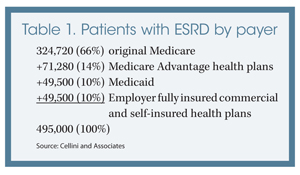
I estimate at least half of dual-eligible beneficiaries (81,182) will be motivated to enroll in Medicare Advantage plans for two reasons: 1) continued Medicaid coordination and payment of copayments and 2) the additional benefits offered by the Medicare Advantage plan. These will vary by plan, but can include transportation, dental, vision and hearing coverage.
Medicare/no Medigap insurance
Approximately 15% of the 324,729 (48,709) have Medicare with no Medigap plan. All of them will probably enroll in Medicare Advantage plans, because of the out-of-pocket maximum of $6,500 and the additional benefits. Beneficiary out-of-pocket costs with original Medicare and no Medigap can currently reach $12,000 or more each year.
Medicare/Medigap secondary
Approximately 30% of the 324,729 (97,428) have Medicare with a Medigap plan. Enrollment in Medicare Advantage plan would cause them to lose their Medigap coverage. It is against the law to sell Medigap coverage to a Medicare Advantage member. The beneficiary would be better off paying monthly Medigap premiums instead of paying copayments until they reach the out-of-pocket maximum, currently $6,500, for Medicare Advantage.
Medicare/commercial secondary
The remaining 5% have Medicare with a commercial secondary. They would not enroll in a Medicare Advantage plan because they would lose their employer-based commercial coverage. Commercial coverage is only available during the 30-month Medicare as a secondary payer (MSP) coordination period. Any time during the coordination period, the beneficiary can cancel their commercial coverage, make original Medicare primary and then make the appropriate coverage decision to enroll in Medicare Advantage.
The net result – an increase in Medicare Advantage plan enrollment to 41% of total patients on dialysis by 2022 – is shown in Table 2.
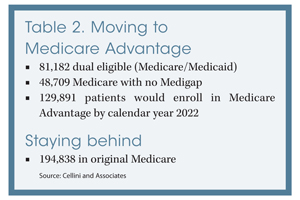
Accountable care organizations
Today, an estimated 32,000 original Medicare beneficiaries with ESRD are attributed to the Centers of Medicare and Medicaid Innovation (CMMI)’s Comprehensive ESRD Demonstration project and 81,397 are attributed to CMS Medicare Shared Savings ACOs.5 Combined, there are approximately 113,000 (35% of the 324,720 covered by original Medicare) already attributed to a Medicare Shared Savings ACO. That could change, however, if CMS moves forward with a plan to eliminate the one-sided risk option for ACOs, something that has received Trump administration support. Smaller providers might withdraw from the ACO model, taking patients with them.
Beneficiaries currently covered by original Medicare will likely decrease to 194,838 by calendar year 2022 (Table 3). If CMS continues its goal to increase alternative payment reimbursement and move away from FFS, the percentage attributed to Medicare Shared Savings ACO models could increase from 35% to 80% or more. This change will be driven by the end of CMMI’s 5-year ESCO demonstration in 2020, the ESCO’s possible replacement, and the continuing expansion of Medicare Shared Savings Program whether or not there is expansion with more two-sided risk agreements.
Section 1115 Medicaid demonstration waivers
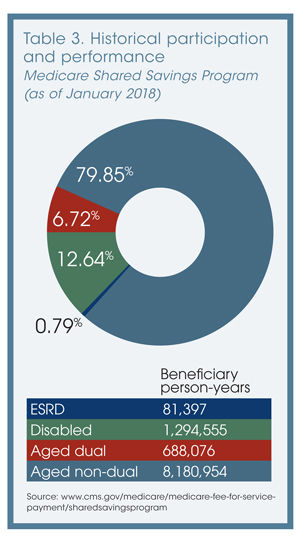
Currently, 46,500 beneficiaries are covered by Medicaid and on dialysis. These patients do not qualify for Social Security and as result, do not qualify for Medicare. They will remain on Medicaid.
Section 1115 Medicaid waivers provide states an avenue to test new approaches in Medicaid that differ from federal program rules. While there is great diversity in how states have used waivers, waivers generally reflect priorities identified by states and CMS. Several states have waivers pending at CMS with new provisions, such as drug screening and testing, eligibility time limits, premiums with disenrollment for non-payment and work requirements.
Each 1115 waiver is different. The purpose of the waiver is to allow states to pilot different ways to manage Medicaid populations by improving the quality of care and reducing costs. States have used the 1115 waivers to transition from utilization-driven FFS Medicaid reimbursement to value-based purchasing. In California, 1115 waivers were used to passively enroll FFS Medi-Cal seniors and persons with disabilities (SPDs) into Medi-Cal managed care health plans. Alabama is using 1115 waivers to implement provider-based regional care organizations (RCOs). In the future, Alabama will transition Medicaid beneficiaries with ESRD away from FFS to these new RCOs. Through a capitated payment, Medicaid health plans and RCOs will manage the full scope of Medicaid benefits, including behavioral health and pharmacy services.
The result of these 1115 waivers will mean more Medicaid beneficiaries with ESRD will be passively enrolled in Managed Care Medicaid Health Plans and RCOs. For a state by state comparison, the Kaiser Family Foundation website tracks each state.6
Dialysis Patient Demonstration Act of 2017
This legislation, if approved by Congress, will establish a new demonstration program under which an unlimited number of organizations created by dialysis providers would be paid based on Medicare Advantage capitated rates for all Medicare services provided to beneficiaries with ESRD.
Essentially, this is a hybrid of an ESCO/ACO and a Medicare Advantage health plan. Beneficiaries with ESRD would remain in FFS Medicare but the organization would receive a Medicare Advantage risk-adjusted capitated payment and, in turn, pay providers based on Medicare reimbursement rates. The newly created DPDA organizations would have to meet the risk-based licensing and solvency requirements of their state’s department of insurance.
The advantages of this model are twofold:
1) There would be no requirement to contract with providers; and
2) There would be fewer regulations than Medicare Advantage ESRD Special Needs Plans.
There is a lot of opposition to this model, including the American Society of Transplantation and Transplant Surgeons, the American Association of Kidney Patients, the Association for Organ Procurement Organizations and the Non-Profit Kidney Care Alliance, which includes Dialysis Clinic Inc.7,8 The two largest dialysis organizations, DaVita Kidney Care and Fresenius Medical Care, are in favor of the legislation.
If the DPDA or something similar passes Congress, I envision 80% or more of those beneficiaries now covered by original Medicare will be attributed to this new model. CMS will develop a demonstration first, similar to what we have seen in the Comprehensive ESRD Care model.
Strategies, tactics to consider
Understanding this payer mix change and developing a plan of action to prepare is important. Clearly, the large dialysis organizations have a competitive advantage based on market share and their dialysis center geographical footprints. However, this does not mean medium and small dialysis providers and nephrologists cannot compete. Health care is still local.
Developing contractual relationships with payers and forming collaborative networks among smaller dialysis organizations and nephrologists will be critical success factors in competing with large dialysis organizations. Here are a few examples based on the type of payer organization.
Medicare Advantage
Given that enrollment in Medicare Advantage health plans could increase to 41% by 2022, dialysis providers who meet the time and distance requirements by CMS for these Medicare Advantage plans will benefit. Medicare Advantage plans contract with CMS on a county by county basis and are responsible to attest that the plan has an adequate network of contracted providers within each county to provide beneficiary access to care. Table 4 provides examples of CMS time and distance from the beneficiary’s home or workplace to their dialysis provider that Medicare Advantage health plans are required to meet.9
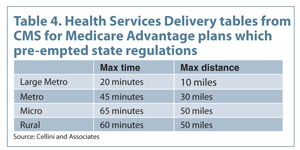
It does not matter if the dialysis center is a certified in-center or home program, the Medicare Advantage Health Service Delivery (HSD) tables treat the centers the same. An effective strategy would be to form collaborative dialysis and nephrologist provider networks and to leverage the use of telehealth services, approved in the Bipartisan Budget Act of 2018 for home dialysis along with the ESCO telehealth waiver and create expanded home dialysis geographical footprints.10 Telehealth for patients on home dialysis becomes effective in January 2019 without geographic restrictions, if the patient is seen at least every 3 months. What this means for HSD tables from CMS is not clear. You can expect further guidance on telehealth from CMS before the end of the year.
Medicaid, future payment models
Like Medicare Advantage, Managed Medicaid Health Plans must meet similar HSD tables, which are regulated by each state. Knowing your state’s department of insurance regulations for HSD tables and telehealth will be important in replicating a strategy like Medicare Advantage. Alternative payment contracting and establishing narrow networks of dialysis centers and nephrologists with these Medicaid Managed Care Plans, Medicaid RCOs and Medicare Advantage health plans will be important in maintaining current referrals and gaining new ones.
The ESCOs are 5-year demonstration projects that expire at the end of calendar year 2020. Will the DPDA replace the ESCOs? What will happen to the Medicare ACOs? Will these increase or decrease as CMS compels these organizations to assume a two-sided financial risk models? The answers to these questions will be driven by legislation and administrative decisions. Legislative changes will come from Congress, while administrative changes will come from CMS. Staying informed of policy changes and being involved in lobbying and educating Congress and CMS is critical.
Based on this review, Table 5 shows how the payer mix could change during the next 4 years (not adjusted for growth).
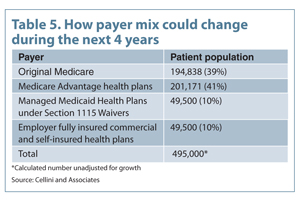
Understanding and planning for these changes in payer mix will ultimately drive competition, referral patterns and determine further consolidation in the industry. Now is the time to reach out to local health plans, RCOs and ACOs to develop deeper clinical relationships and secure provider agreements incorporating alternative payment models, narrower networks and telehealth.
- References:
- United States Renal Data System, 2017 Annual Report. www.usrds.org/adr.aspx
- www.milliman.com/insight/2017/how-CMS-payments-to-medicare-advantage-plans-differ-for-ESRD-beneficiaries-versus-other-medicare-beneficiaries
- www.congress.gov/bill/114th-congress/house-bill/34/text
- www.medicareadvocacy.org/barriers-to-medi-gap-coverage-for- beneficiaries-under-age- 65/
- CMS Medicare Shared Savings Program, Fast Facts, January 2018. www.cms.gov/medicare/medicare-fee-for-service-payment/sharedsavingsprogram/downloads/SSP-2018-fast-facts.pdf
- www.kff.org/medicaid/issue-brief/which-states-have-approved-and-pending-section-1115-medicaid-waivers
- https://asts.org/advocacy/legislative-issues/patients-act-talking-points#.Wz5EMNJKgdU
- www.nonprofitkidneycare.org
- HSD Reference File 01-01-2018. www.cms.gov/medicare/medicare-advantage/medicareadvantageapps/index.html
- Bipartisan Budget Act of 2018. www.congress.gov/115/bills/hr1892/bills-115hr1892enr.pdf
- For more information:
- Gary L. Cellini, PharmD, MBA, is a health care management consultant with subject matter expertise in renal disease and alternative payment models, including several renal disease CMS demonstration projects and Medicare Advantage ESRD Special Needs Plans. Previously, he was a board member of the Renal Services Exchange; president of Satellite Health Plan, an ESRD Medicare Advantage Special Needs Plan; vice president of Strategic Initiatives for Satellite Healthcare; and director of government programs and administration for DaVita VillageHealth. He can be reached at glcellini@gmail.com. Disclosure: Cellini reports no relevant financial disclosures.
